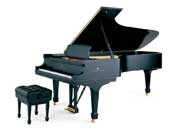Tuesday evening’s quintet of pianists inspired a variety of reactions in a tradition-heavy choice of repertory leavened by two post-1950 pieces and the different sounds of the contest’s two Steinways. The stagehand was busy swapping out no. 1 (a mellow, bass rich New York instrument) with no. 2 (a brighter in the treble — and under some fingers rather steely — instrument made in Hamburg). It was interesting to see which piano each performer chose.
The evening began with Piano. No. 1 and Ukrainian pianist Anzhelika Fuks’ presentation of Sosjko’s Sofija Kijevsjka, an impressionistic soundscape that began with dramatic low notes and progressed to chord clusters and pointillism. (Anybody know anything about this composer and work? Please share!) Fuks’ Bach (the b-flat minor Prelude & Fugue from WTC II) was momentarily derailed in the fugue by the first real memory slip we’ve heard so far. Mozart’s Sonata in E-flat, K. 282 sounded subdued. Fuks, who has an impressive resume, seemed to be having an off night.
Gerhard Vielhaber (Germany, Piano No. 2) began with the strangely wonderful Beethoven Sonata in D, op. 10, no 3, choosing not to dwell on its musical and formal curiosities but delivering a straightforward performance that made good sense and inspired a few shouts of ‘bravo’. Chopin’s Etude in b, op. 25, no. 10 is a big octave extravaganza that kept Vielhaber’s hands full but not overwhelmed, and the lyrical middle section was handled beautifully.
Michael Brown (USA) wisely chose to play a well-organized mini-recital on Piano No. 1. Beginning with a singing performance of Bach’s Prelude & Fugue in C (WTC II) featuring well articulated runs and an energetic fugue, he turned next to a healthy sounding reading of Beethoven’s Sonata in F, op. 54 characterized by sureness of touch and voicing (great octaves!) and very little use of pedal. And now for something completely different: George Perle’s Six Celebratory Inventions (marking milestones in the lives of fellow composers Ernest Krenek, Henri Dutilleux, Olivier Knussen, Gunther Schuller, Richard Swift & Leonard Bernstein). Amusing, witty and treacherous for the pianist, Brown played them lovingly and with astonishing accuracy and attention to dynamics. The finale to this tiny but impressive recital: Chopin’s ‘Revolutionary’ Etude, op. 10, no. 12. My notes read simply ‘Wow!’
After intermission and yet another switchover to Steinway No. 2, Kwan Yi (USA) and Kuok-Wai Lio (China) brought the evening to a conclusion with very different approaches to classical repertory.
Yi was a formidable machine, playing Beethoven’s Sonata in C, op. 2, no. 3, and Chopin’s Etude in a, op. 10, no. 2 (nonstop line in the right hand) with faultless technique, high energy and quirky body language.
A tall and gangly 20-year old, Lio was the picture of poetic elegance, sitting far back from the keyboard and choreographing every release (at one point, his left hand hovered in the air while the right delivered a mini-cadenza). He began with a sensitive, clear performance of Bach’s Prelude & Fugue in b minor (WTC II) notable for some overarticulations in the fugue subject, followed by a nuanced and well-shaped reading of Haydn’s Sonata in E-flat (Hob. XVI:49). He ended with a spacious and impressive trip through Chopin’s Etude in F, op. 10, no. 8, beautifully presenting the left hand melody against faultless filigree in the right.
Each pianist’s performance can be revisited thanks to a partnership between the Cleveland International Piano Competition and InstantEncore. Wednesday evening’s session should be posted later today.




